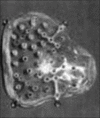Cranioplasty: Review of materials and techniques
- PMID: 21897681
- PMCID: PMC3159354
- DOI: 10.4103/0976-3147.83584
Cranioplasty: Review of materials and techniques
Abstract
Cranioplasty is the surgical intervention to repair cranial defects. The aim of cranioplasty is not only a cosmetic issue; also, the repair of cranial defects gives relief to psychological drawbacks and increases the social performances. Many different types of materials were used throughout the history of cranioplasty. With the evolving biomedical technology, new materials are available to be used by the surgeons. Although many different materials and techniques had been described, there is still no consensus about the best material, and ongoing researches on both biologic and nonbiologic substitutions continue aiming to develop the ideal reconstruction materials. In this article, the principle materials and techniques of cranioplasty are reviewed.
Keywords: Allograft; autograft; cranioplasty; reconstruction; skull defects.
Conflict of interest statement
Figures





References
-
- Sanan A, Haines SJ. Repairing holes in the head: A history of cranioplasty. Neurosurgery. 1997;40:588–603. - PubMed
-
- Rish BL, Dillon JD, Meirowsky AM, Caveness WF, Mohr JP, Kistler JP, et al. Cranioplasty: A review of 1030 cases of penetrating head injury. Neurosurgery. 1979;4:381–5. - PubMed
-
- Blake DP. The use of synthetics in cranioplasty: A clinical review. Mil Med. 1994;159:466–9. - PubMed
-
- Prolo DJ, Burres KP, McLaughlin WT, Christensen AH. Autogenous skull cranioplasty: Fresh and preserved (frozen), with consideration of the cellular response. Neurosurgery. 1979;4:18–29. - PubMed
-
- Viterbo F, Palhares A, Modenese E. Cranioplasty: The autograft option. J Craniofac Surg. 1995;6:80–3. - PubMed
LinkOut - more resources
Full Text Sources
Other Literature Sources
Medical
